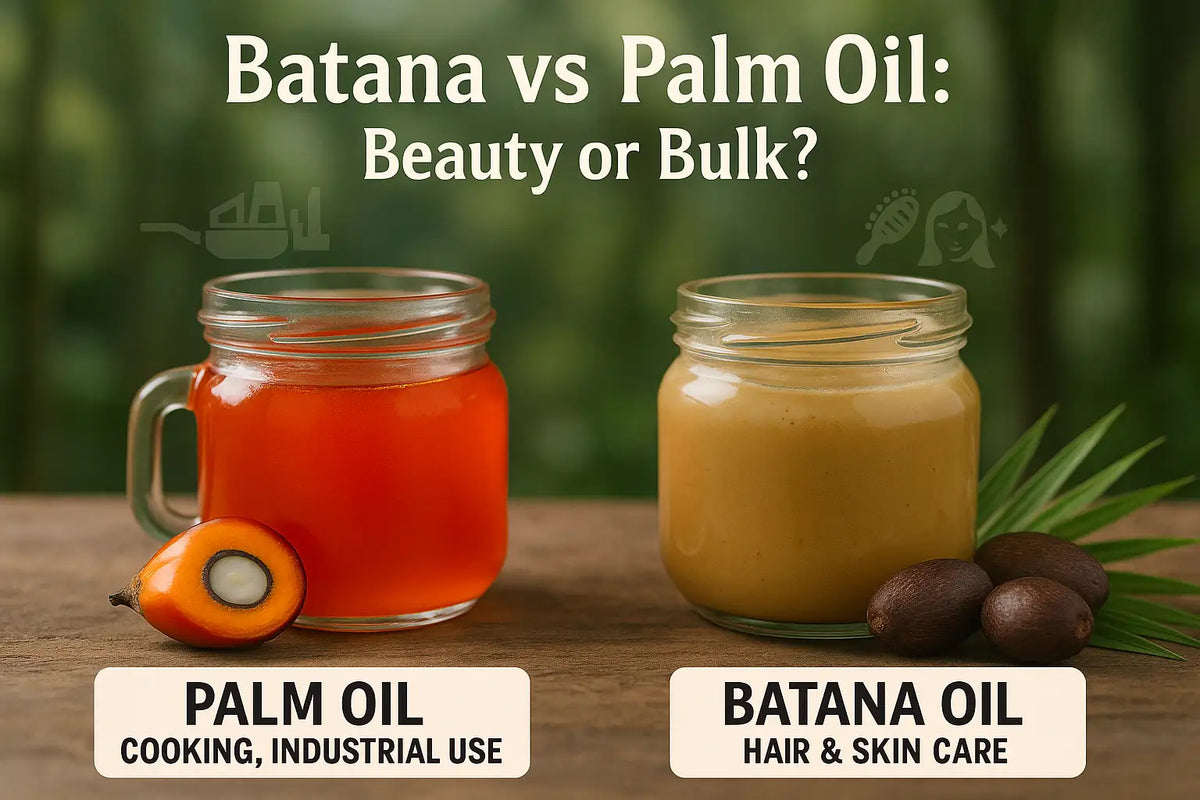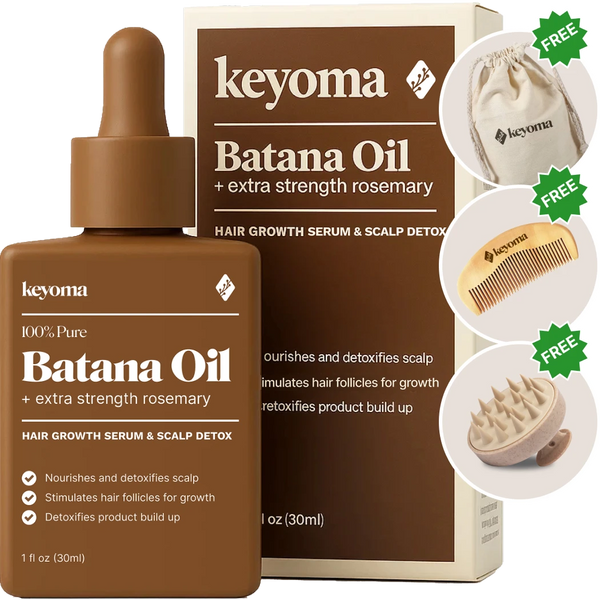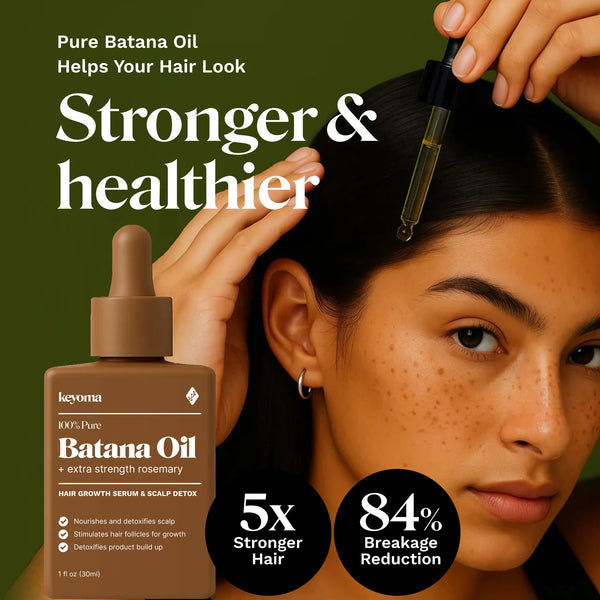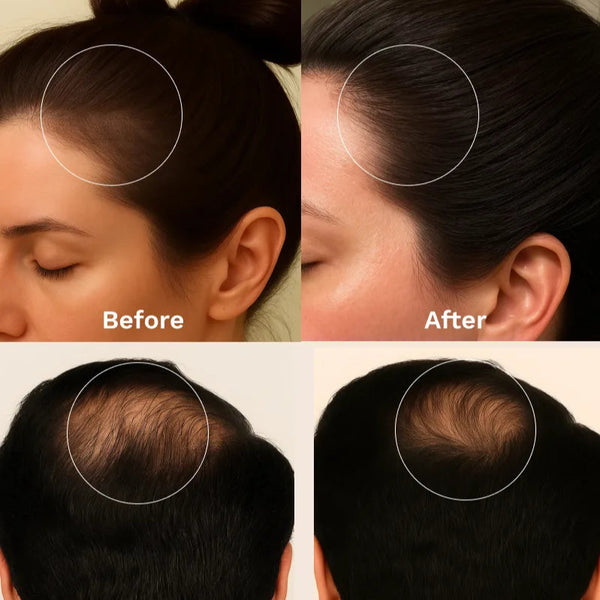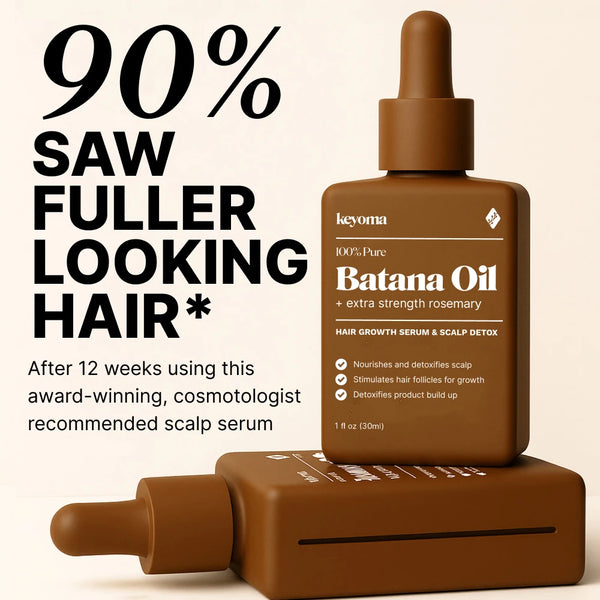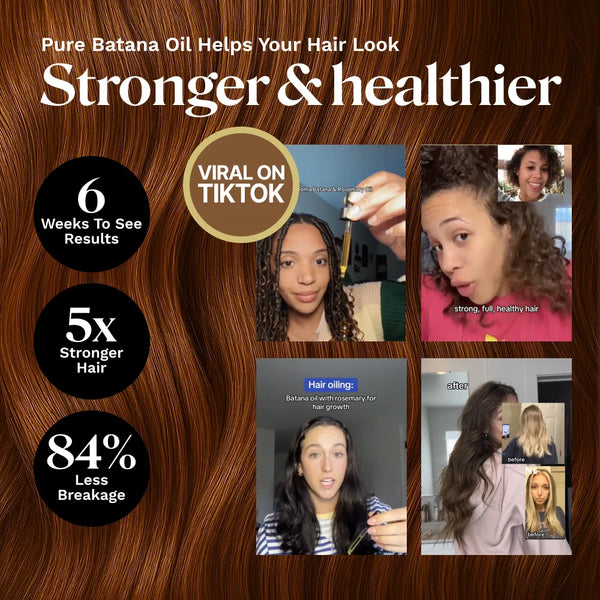In this article
We’ve received plenty of questions about the difference between Batana Oil and Palm Oil, so let’s clear things up and make it easy to understand.
Although both oils come from palm trees, they differ in origin, purpose, and environmental footprint. Batana Oil, which we extract from the American palm tree, is prized for its rich benefits for hair and skin. In contrast, Palm Oil, often used in cooking, raises more environmental concerns.
We’ll show you why Batana Oil is a better choice for beauty routines, how each oil affects sustainability, and what makes their cultural roots so unique. Let’s explore their distinct uses and discover which one suits your needs best.
What Is Palm Oil and How Is It Used?
Palm oil is extracted from the soft, fleshy pulp of the palm fruit. Its deep reddish-orange color comes from its high carotenoid content, including beta-carotene.
You will find palm oil in all kinds of products—from food to skincare to industrial materials—mainly because it is versatile and inexpensive to produce. Its adaptability and cost-effectiveness make it a go-to ingredient across many industries.
What Is Batana Oil and Why It’s Gaining Attention
Batana oil, on the other hand, is made from the kernel or seed found inside the palm fruit, not the fleshy pulp. It is typically sourced from palm species like Elaeis oleifera in Honduras and Elaeis guineensis in parts of West Africa.
The oil is traditionally extracted by roasting the kernels and then pressing them to release their natural oils. So at its core, Batana oil is a type of palm kernel oil, known for its rich texture and nourishing properties.
Batana Oil vs Palm Oil: Key Differences
Here’s where things start to get intriguing. Palm kernel oil from West Africa and Batana oil from Honduras appear nearly the same. This makes sense, as palm trees across tropical regions—from West Africa to Malaysia to South America—share a similar appearance.

Naturally, their fruits and seeds often look alike as well. Still, the exact palm species can vary, and communities in each region have their own traditional names for these trees.
Palm Oil and Batana Oil serve different purposes. Here’s a quick comparison:
Where Each Oil Comes From
-
Palm Oil: Sourced from the flesh of the oil palm fruit (Elaeis guineensis), commonly cultivated in tropical areas such as Southeast Asia, parts of Africa, and South America.
-
Batana Oil: Extracted from the seeds of the American palm (Elaeis oleifera), a species native to Central and South America, with notable production in Honduras.
Color and Texture Compared
-
Palm Oil: Known for its bright reddish-orange hue, this oil contains high levels of beta-carotene and remains semi-solid at room temperature.
-
Batana Oil: Usually golden-brown in color, it has a creamy, smooth consistency when warm and turns solid in cooler conditions.
Nutritional Content of Palm vs Batana Oil
-
Palm Oil: Contains a high concentration of saturated fats, especially palmitic acid, and also provides vitamins A and E.
-
Batana Oil: Offers a blend of saturated and unsaturated fats, with notable amounts of oleic acid. It is also packed with essential fatty acids, antioxidants, and nourishing vitamins.
Common Uses for Palm and Batana Oil
-
Palm Oil: Commonly used in the food industry for frying, baking, and producing margarine, snack items, and processed foods. It also appears in cosmetics, soaps, and biodiesel manufacturing.
-
Batana Oil: Mostly found in beauty and personal care products, especially those targeting hair and skin. It is valued for its ability to repair, hydrate, and protect, making it ideal for treating dry, brittle, or damaged hair. It’s also a key ingredient in moisturizing skincare formulas.
Environmental Impact of Palm and Batana Oil
-
Palm Oil: Large-scale production has been linked to deforestation, loss of wildlife habitats, and reduced biodiversity, especially in Southeast Asia, raising major environmental concerns.
-
Batana Oil: Typically produced in smaller quantities by indigenous communities, its harvesting methods are considered more sustainable and tend to have a lower impact on forests and local ecosystems.
Health Benefits: Batana Oil vs Palm Oil
-
Palm Oil: Offers a source of energy and supplies fat-soluble vitamins, but its high saturated fat content has raised health concerns, particularly regarding heart disease when consumed in large amounts.
-
Batana Oil: Celebrated for its restorative benefits, especially in hair and skin care, it does not carry the same dietary controversies. It is often praised for improving hair strength, softness, and overall appearance.
Cultural Importance and Market Demand
-
Palm Oil: Plays a major role in global industries and holds strong economic value for many producing nations.
-
Batana Oil: Holds deep cultural importance in areas like Honduras, where the Miskito people have long used it for hair care. It is now gaining international recognition as a high-quality ingredient in natural beauty products.
Lauric vs Oleic Acid: What Helps Hair and Skin Most?
While the unrefined versions of their kernel oils may look and function similarly, studies indicate that their fatty acid profiles differ slightly depending on the palm tree species. Additional research reveals that:
-
Honduran Batana Oil: Features a higher concentration of oleic acid (45–75%), a monounsaturated fat often recognized for its health benefits. It also includes linoleic acid (22–32%), palmitic acid (6–14%), and myristic acid (2–5%).
-
West African Palm Oil: Contains a greater amount of lauric acid (around 46%), a saturated fat valued for its strong antimicrobial effects. Other notable fatty acids include myristic acid (about 16%), oleic acid (15%), and palmitic acid (6–14%).
Which Fatty Acid Supports Hair Health?
Lauric acid (African Palm Kernel Oil), which is especially abundant in West African palm kernel oil, offers a mix of benefits for your scalp and hair. It has strong antimicrobial and antifungal properties, and research suggests it can help balance the scalp’s microbiome. That means fewer flare-ups like dandruff and irritation.
One reason lauric acid works so well is its small molecular size. It can slip into the hair shaft more easily than many other oils, helping to strengthen strands and reduce protein loss. That alone makes it a great ally for damaged or brittle hair.
And there is more. Another study found that lauric acid helps deliver hair growth oils deeper into the follicles. As a result, participants saw thicker, stronger hair and noticed less shedding after consistent use.
Oleic acid (South American Kernel/Batana Oil), found in high concentrations in Batana oil, helps boost the absorption of active ingredients like Minoxidil by improving how well they penetrate the hair follicles. This makes Batana oil a useful companion for certain hair loss treatments, especially those that rely on topical application.
But its benefits are more targeted. And while it can enhance product delivery, some studies have pointed out that using oils rich in oleic acid over a long period may lead to dandruff in certain individuals.
In contrast, the same research highlights lauric acid’s antifungal power. Lauric acid helps rebalance the scalp’s microbiome and reduce dandruff, making it a better choice for those dealing with irritation or flaking.
Batana Oil vs Palm Oil for Skin: What to Know
Oils rich in oleic acid are often praised for their nutritional benefits when eaten, but they might not be the best choice for skincare—especially if you have acne or eczema. Studies show that oleic acid can clog pores and worsen breakouts, particularly in people with oily or blemish-prone skin.
When it comes to eczema, the concerns go even deeper. Research has found that oleic acid can weaken the skin’s natural barrier by disrupting its lipid structure.
This makes the skin more permeable to irritants and allergens, which can lead to increased inflammation and more severe eczema symptoms over time. And in infants, whose skin is thinner and more delicate, oleic acid has been shown to trigger or worsen eczema.
Lauric acid offers a gentler alternative. Found in high amounts in West African palm kernel oil, it has natural antimicrobial and anti-inflammatory properties that help fight acne-causing bacteria and calm irritated skin. Its lighter texture also makes it less likely to clog pores.
And for those with eczema, lauric acid’s soothing and hydrating qualities can provide real relief. It is a more skin-friendly option for sensitive, oily, or easily irritated skin types.
Choose The Best Oil for Your Hair With Keyoma’s Batana Oil
After reading this guide, you should now have a clearer understanding of how batana oil differs from palm oil. Batana oil is packed with antioxidants, essential fatty acids, and vitamins that help promote stronger, softer, and healthier hair.
While palm oil can act as a basic moisturizer, it does not compare to the deep nourishment and restorative properties of batana oil. In addition, palm oil is often linked to unethical sourcing practices and large-scale environmental damage. In contrast, batana oil is typically produced on a smaller scale, often by local communities, making it a more ethical and sustainable choice.
If you are ready to experience the full benefits of batana oil, try Keyoma Batana Oil. Our pure, ethically sourced formula gives your hair the care it deserves. Restore shine, strengthen strands, and support your scalp naturally with every use.
Featured Product
100% Pure Batana Oil + Rosemary
↓Best Batana Oil to Buy↓
1 Month
Subscribe & Save
- 30-day supply delivered monthly $35
- 30% off for life $6
- Free haircare essentials kit $33
- Free custom wooden comb $10
- Free scalp massager $15
- Free eco-friendly travel bag $8
- 30-Day Money Back Guarantee
- Free Shipping
- Online portal for easy cancel, skip, or pause.
1 Month One Time Purchase
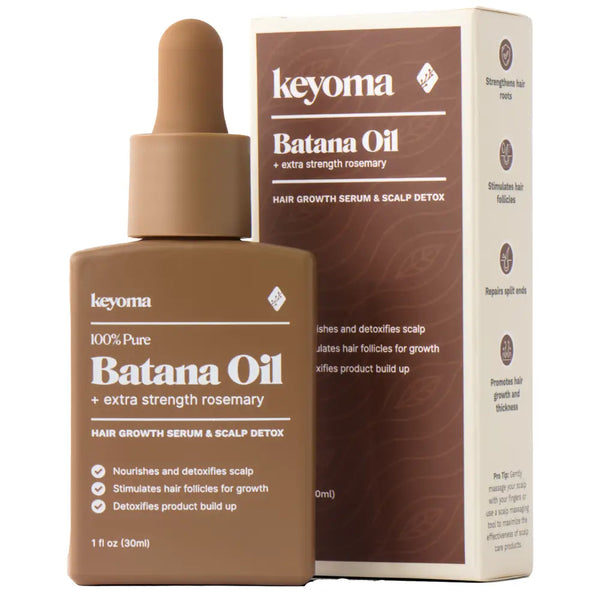
- 30-day supply $50
- 30% off for life $6
- Free haircare essentials kit $33
- Free custom wooden comb $10
- Free scalp massager $15
- Free eco-friendly travel bag $8

